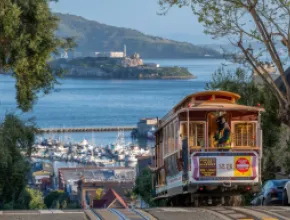Three years after the onset of the recession, CVBs and other destination management organizations (DMOs) across the country continue to be victims of the gyrating U.S. economy.
It’s a divergent landscape. While many DMOs have lost funds from their state and local governments, some continue to get revenue boosts from theirs.
Victoria Isley, executive vice president and chief operating office of DMAI, notes that “DMO budgets in the U.S. have returned to 2008 levels, but have not surpassed them.”
The contrasting tourism marketing revenue across the country has much to do with state and local legislators’ views of the industry, she says, adding that some lawmakers regard tourism and hospitality as an expense, while others regard the industry as an investment.
“We haven’t been good at marketing ourselves to politicians and legislators because we haven’t spoken their language,” she says. “What they need to realize is what the industry contributes to the local economy and that destinations are importing temporary taxpayers every day and they don’t require city services like schools and roads. They make major impacts on destinations, and are part of the solution, not an expense.”
Targeting Travelers
What’s significant for meeting planners and attendees is that DMOs that are struggling for revenue are increasingly asking visitors to foot the bill—in the form of new assessments and higher taxes on hotel stays, car rentals and other travel-related services.
DMOs in California, Washington and Pennsylvania are among those who are turning to other sources to replace lost state funding.
Pennsylvania has cut its destination grants by about 75 percent since 2007, and Washington closed its tourism offices in June, making it the only state without that resource.
In California, tourism improvement districts (TIDs), also known as tourism marketing districts (TMDs), have gained popularity in recent years as state funding has disappeared and DMOs face increasing competition from well-funded destinations outside the state. Nearly 60 California DMOs have adopted the TID model to date.
John Lambeth, president of Civitas Advisors, a Sacramento, Calif., firm that specializes in forming and modifying TIDs across the U.S., says the districts typically raise revenue from assessments on hotel room stays, an assessment on top of bed tax. Funds are managed by a DMO, with representatives of assessed businesses, including hotels and restaurants, sitting on the boards.
According to Lambeth, the largest TID in the country was created last year when the federal government levied a $10 fee on foreign visitors that is bringing in about $320 million annually for national tourism marketing.
Los Angeles is the most recent California city to create a TMD. The city council in June approved a new 1.5 percent hotel room assessment that is estimated to add about $11 million a year to market L.A. as a business and leisure travel destination.
A TID, which implemented a 2 percent assessment on top of the existing 12 percent hotel tax, was approved for California’s Napa Valley about a year ago. According to Clay Gregory, president of the Napa Valley Destination Council, the assessment has taken his budget from about $500,000 two years ago to about $4.5 million today.
“We have had absolutely no backlash from travelers about it,” he says. “The uptick in revenue has enabled us to do a much more robust public relations and media marketing program, create a mobile app, participate in more trade shows than we used to, increase our media advertising and take our staff from three to 13 employees.
“We love the TID because it makes the destination self-reliant, not having to beg governments every year for funds,” he continues. “And another great thing about it is that even though the county and city of Napa administer the funds, only 1 percent stays with the county for administrative purposes. The rest goes into marketing the destination.”
In downtown Seattle, hotel owners have been considering a $2-per-night room tax to fund advertising that would promote travel to the city, particularly in slower months. If passed, that fee will add to the 15.6 percent tax Seattle hotel guests already pay in sales and room taxes, which go in part toward paying off debt on the Washington State Convention Center and promoting Seattle as a business and convention destination.
Travel taxes aren’t the only resources DMOs are mining for revenue. Local industries are also being tapped to fill in the gaps.
Craig Davis, vice president of sales and marketing for Visit Pittsburgh, says his DMO funding from the state has been in decline since 2008. State grants used to provide around $3 million annually toward tourism marketing, but that has been eliminated from the 2011-2012 state budget.
“We’ve obviously have had to make cuts,” Davis says, “but we’ve been careful to ensure that visitor and group services aren’t impacted. We managed to glean funds from local foundations and the banking and energy sectors—about 156 percent over last year—and tax collections are up because business has increased 15 percent year over year.”
The Haves
While some destinations are turning to higher tourism taxes for what they can’t get from their state and local governments, other destinations, such as the states of Virginia, Florida and Michigan are enjoying a symbiotic funding dance with theirs.
Virginia’s Gov. Bob McDonnell recently announced a fiscal year budget surplus of over $500 million, with tourism a beneficiary.
“Virginia has increased its tourism funding over last year, and so has the state of Florida,” says Landon C. Howard, executive director of the Roanoke Valley [Va.] CVB.
“The state money we have received to market our destination has made an incredible difference,” he continues. “Tourism is doing much better this year, and more jobs have been created. Our state has certainly seen a lot of promise from tourism investing.”
Michigan is another state that supports tourism with funds for DMO marketing. The Michigan Economic Development Corporation matched $3 million in contributions by private sector entities from 28 Michigan communities and destinations to garner a $6 million local and national media campaign to promote “Pure Michigan” during 2011. At mid-year, traveler spending in Michigan was up 13.7 percent over 2010.
According to Chris Baum, senior vice president of sales and marketing for the Detroit CVB, the spending tide is benefitting Detroit, where traveler taxes are among the country’s lowest.
“We are funded by hotel tax, and because our hotels are doing so well, our revenues are up,” he says. “We are about 10 percent over our objectives this year, and about 14 percent over last year. Meeting planners should know our negative issues are behind us. Billions are going into our downtown infrastructure, including the Detroit Convention Center. It’s undergoing a $300 million transformation and when it’s complete in 2014, you won’t recognize it.”






